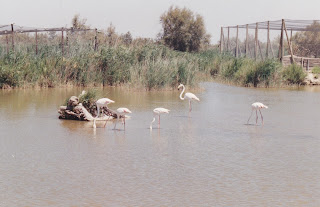Almost
fifty years ago I drove down to the south of France with a friend, in his
little Morris Minor convertible, painted bright orange (this was the 1960s,
after all!). We ended up in a youth hostel in a village called Salin-de-Giraud,
very near the coast in the Camargue.
Some days we spent in the sea, but we also went on a trek with the
famous white horses, we visited Arles and Nimes and the Pont du Gard aqueduct,
and the village of Les Baux-en-Provence. Salin-de-Giraud had its own little
arena for bullfights, but they couldn’t afford to kill the bull; instead they
merely provoked it to charge and vaulted to safety over a wooden barrier.
Occasionally the bull leapt over the barrier after them, causing confusion.
I
liked Arles so much that I booked it for our honeymoon. The Ballet Rambert were
performing in the Roman theatre, and were staying at our hotel. In the
afternoon all these fit young men with bulging thigh muscles would appear at
the swimming pool. We walked round the town and took a bus through the Camargue
and down to the coast at Saintes-Maries-de-la-Mer. This summer I returned to
Arles after a long break.
Arles
is an ancient city, dating back to Roman times, when it was named Arlete
Sextanorum. It retains a well-preserved Roman theatre and arena.
But I found
this summer that, unlike on previous visits, we now had to pay to look at the
theatre. It was expensive to visit the arena, and I’m sure you are no longer
allowed to walk round the top. From the late Roman period comes the Alyscamps;
a Christian burial site which is now reduced to a tree-lined lane of tombs.
The most famous relic from the early Middle
Ages, Saint Trophime church, where Frederick Barbarossa was crowned Holy Roman
Emperor in 1178, was just as I remembered. There is a splendid west front,
featuring a Last Judgement,
Nowadays,
Arles makes much of its links with Van Gogh. His room has been recreated, and also
the gardens of the asylum where he stayed. One can see what he meant about the
wonderful light in the region.
South
of Arles is the Camargue; a roughly triangular area of swampy land, some of
which has been drained for farming (including some rice paddies), while the
rest remains a wilderness of marshes.
Here you can see the famous white horses,
Here you can see the famous white horses,
flamingos if you are lucky,
and the black cattle whose bulls fight in the
arenas.
On the coast is the little town of Saintes-Maries-de-la-Mer, where Van
Gogh painted the fishing-boats on the beach;
and which is now a seaside resort. The name is plural, because a whole boatload of saints are said to have landed here. The church has a collection of charmingly naïve paintings of residents who have been helped by the saints.
and which is now a seaside resort. The name is plural, because a whole boatload of saints are said to have landed here. The church has a collection of charmingly naïve paintings of residents who have been helped by the saints.
A
new site for me was Aigues-Mortes, the port from where Louis IX (Saint Louis)
set sail on his ill-fated crusade in 1248. The sea has now retreated, and what
is left is a time-warp: a charming little mediaeval walled city, whose sole
remaining function is tourism.
Nimes,
on the western edge of the Camargue, is famous for its massive amphitheatre
It also now has a marvellous new museum, which currently houses a superb display related to gladiators. Sadly, not a single booklet or postcard was offered for sale!
Finally
we visited the Pont du Gard; the enormous Roman aqueduct across the river north
of Nimes. I would have to say it was a touch disappointing. Half a century ago
we visited it for free, and walked along the top. Now we found an elaborate
visitor centre, fifteen coaches full of tourists, expensive tickets, and
certainly no access onto the aqueduct itself. One can only say: that’s
progress!


















No comments:
Post a Comment